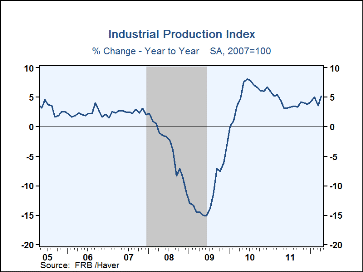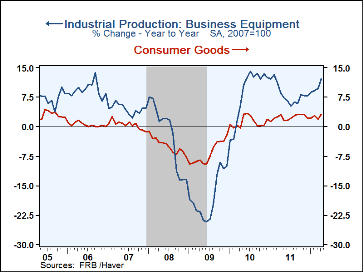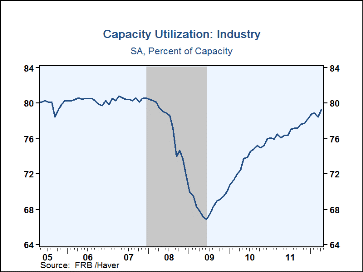 Global| May 16 2012
Global| May 16 2012U.S. Industrial Output Rebounds With Utility Gain
by:Tom Moeller
|in:Economy in Brief
Summary
Overall industrial output posted a 1.0% increase last month following a 0.5% March decline, initially reported as no change. The gain doubled Consensus expectations for a 0.5% increase according to Action Economics. A 4.6% (1.2% y/y) [...]
 Overall industrial output posted a 1.0% increase last month following a
0.5% March decline, initially reported as no change. The gain doubled
Consensus expectations for a 0.5% increase according to Action Economics.
A 4.6% (1.2% y/y) surge in utility output, due to the warm spring, led
last month's improvement. Factory sector output gained a lesser 0.5% (5.7%
y/y) following a 0.4% March drop, revised from -0.2%.
Overall industrial output posted a 1.0% increase last month following a
0.5% March decline, initially reported as no change. The gain doubled
Consensus expectations for a 0.5% increase according to Action Economics.
A 4.6% (1.2% y/y) surge in utility output, due to the warm spring, led
last month's improvement. Factory sector output gained a lesser 0.5% (5.7%
y/y) following a 0.4% March drop, revised from -0.2%.
Business equipment production continued strong versus other sectors with a 1.5% rise (12.0% y/y). Consumer goods output increased 0.9% (3.1% y/y) during April led by a 2.4% gain (21.9% y/y) in auto production. Computers, video and audio production followed with a 1.3% rise (5.3% y/y) while appliances, furniture & carpeting also gained 1.3% (3.7% y/y). In the weaker nondurables area, clothing output was unchanged (-2.1% y/y), chemicals slipped 0.1% (-1.9% y/y) and paper products output also was unchanged (0.1% y/y).
Capacity utilization rose to 79.2% last month, its highest level in four years, due to the gain in utility output. In manufacturing alone, utilization ticked up to 77.9% and remained up from the recession low of 64.4%. Overall capacity is estimated to have risen 1.1% y/y following a 0.2% dip last year and a 2.0% decline during 2010. In the factory sector, capacity rose 0.7% y/y and excluding the high-tech industries, it increased 0.3%.
Industrial production and capacity data are included in Haver's USECON database, with additional detail in the IP database. The expectations figure is in the AS1REPNA database.
| Industrial Production (SA, % Change) | Apr | Mar | Feb | Apr Y/Y | 2011 | 2010 | 2009 |
|---|---|---|---|---|---|---|---|
| Total Output | 1.0 | -0.5 | 0.4 | 5.2 | 4.1 | 5.4 | -11.4 |
| Manufacturing | 0.4 | -0.5 | 0.6 | 4.8 | 4.3 | 5.7 | -13.8 |
| Consumer Goods | 0.9 | -0.5 | 0.5 | 3.1 | 2.3 | 1.1 | -6.9 |
| Business Equipment | 1.5 | 0.3 | 1.3 | 12.0 | 8.2 | 8.3 | -18.2 |
| Construction Supplies | 0.0 | -1.6 | 2.1 | 6.5 | 5.6 | 3.8 | -22.9 |
| Materials | 1.3 | -0.8 | -0.1 | 5.1 | 4.6 | 8.4 | -11.5 |
| Utilities | 4.6 | 0.6 | 1.2 | 1.2 | -0.3 | 3.6 | -2.5 |
| Capacity Utilization (%) | 79.2 | 78.4 | 78.9 | 76.1 | 76.8 | 73.7 | 68.5 |
| Manufacturing | 77.9 | 77.6 | 78.0 | 74.3 | 75.0 | 71.3 | 65.5 |
Tom Moeller
AuthorMore in Author Profile »Prior to joining Haver Analytics in 2000, Mr. Moeller worked as the Economist at Chancellor Capital Management from 1985 to 1999. There, he developed comprehensive economic forecasts and interpreted economic data for equity and fixed income portfolio managers. Also at Chancellor, Mr. Moeller worked as an equity analyst and was responsible for researching and rating companies in the economically sensitive automobile and housing industries for investment in Chancellor’s equity portfolio. Prior to joining Chancellor, Mr. Moeller was an Economist at Citibank from 1979 to 1984. He also analyzed pricing behavior in the metals industry for the Council on Wage and Price Stability in Washington, D.C. In 1999, Mr. Moeller received the award for most accurate forecast from the Forecasters' Club of New York. From 1990 to 1992 he was President of the New York Association for Business Economists. Mr. Moeller earned an M.B.A. in Finance from Fordham University, where he graduated in 1987. He holds a Bachelor of Arts in Economics from George Washington University.








